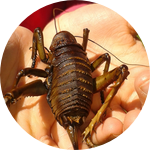Please wait...
About This Project
The South Georgia Diving Petrel is a tiny, highly specialized, wing-propelled diver; a 'flying penguin'. The New Zealand population is nationally critical and numbers 150 individuals only. Storms are the main terrestrial threat, but offshore threats remain unknown. Complete understanding of all threats is paramount to guide successful conservation management. Thanks to generous backers, it may also be possible to assess juvenile mortality to further fine-tune conservation management.

Browse Other Projects on Experiment
Related Projects
How do polar bears stay healthy on the world's worst diet?
Polar bears survive almost entirely on seal fat. Yet unlike humans who eat high-fat diets, polar bears never...
Uncovering hidden insect diversity associated with a likely undescribed gall-forming midge
Does a likely undescribed species of gall-forming midge (pers. comm. Ray Gagné) on Eriodictyon plants (Yerba...
Macrofungi of the California archipelago
The eight islands of the California Archipelago are a well-studied biodiversity hotspot — but we know almost...





